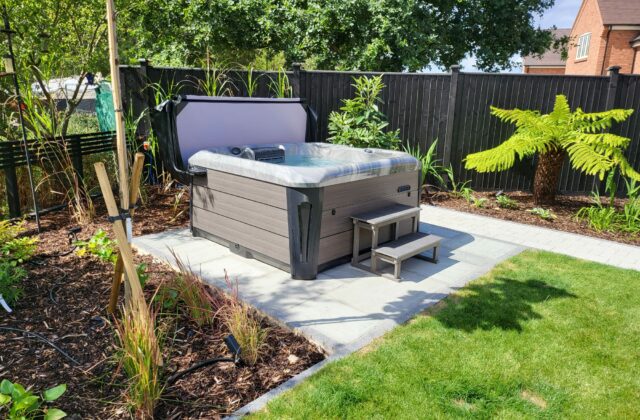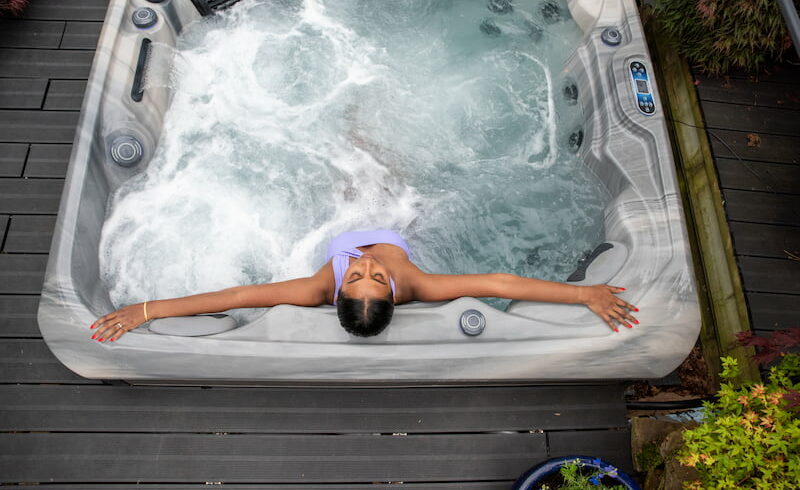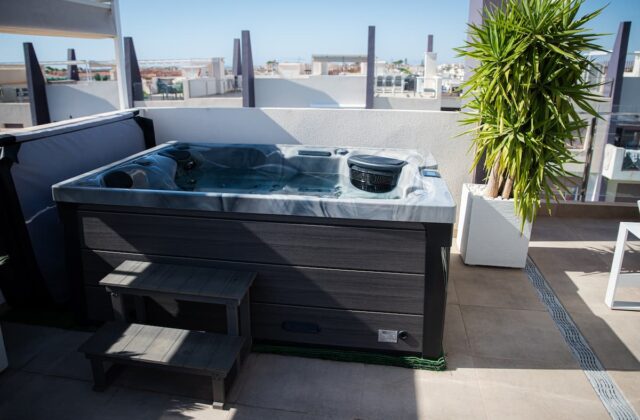Investing in a hot tub can be a great way to relax, socialise, or even experience hydrotherapy benefits, all from the convenience of your own garden. However, with the ownership of a hot tub, comes the responsibility of cleaning it and keeping it in good condition.
Part of this responsibility is making sure that your hot tub’s water is at the right pH level, and therefore safe to use. This guide will cover what you need to know when it comes to keeping your hot tub’s water in the best condition.
How to Balance Your Hot Tub’s pH Level
You can balance your hot tub’s pH level by either increasing or decreasing the pH level by using pH adjusters. The aim is to get your hot tub’s water to a pH level of 7.2 – 7.4, which makes it safe to enjoy, while also being beneficial to the lifespan of your hot tub’s components. Part of adjusting the pH level is making sure your Total Alkalinity level is between 100 – 150 ppm, which will help to stabilise the water’s pH level.
What is a pH Level?
Before we get started on how you can measure and adjust your hot tub’s pH level, you might be wondering, “what is a pH level?”.
Put simply, the pH level is a measurement of how acidic or basic your hot tub’s water is. The pH scale goes from 0-14, with 7 being a neutral level – an example of a neutral level substance is pure water. The closer you get to 0 on the pH scale, the more acidic a substance is, and the closer to 14, the more basic (sometimes known as an alkaline) a substance gets.

Source: BBC – The pH scale.
Why are pH Levels Important For Hot Tubs?
The pH levels are important to consider for hot tubs because you want the water in it to be between 7.2 – 7.4 on the pH scale, which would mean your water is very close to neutral and therefore safe to enjoy your time in.
Unfortunately, chemicals are needed to keep your hot tub’s water clean and safe from bacteria, which will start to slowly change your hot tub’s pH levels. Additionally, the pH levels of the water will change as it gets used more, as even the natural oils from your skin will make a small impact on the pH.
To make sure your hot tub stays in the best condition it can, while also keeping everyone who uses it safe, it is recommended to test your water’s sanitiser, pH, and alkalinity levels regularly, and then make adjustments as necessary.
How to Measure a Hot Tub’s pH Level
Fortunately, measuring your hot tub’s pH level, along with its sanitiser and alkalinity level, is very easy these days. There are many hot tub water testing kits available to buy, often seen in the form of a testing strip, and these can be used to measure the pH, sanitiser, and alkaline levels of your water.
A good testing kit will even tell you the recommended amount of chemicals needed to correctly adjust your hot tub’s water to get it back to the ideal levels.
Having The Wrong pH in Your Hot Tub
We’ve mentioned that having the wrong pH level in your hot tub can make the water too acidic or basic, but what does that mean in practical terms?
Low pH Levels
A pH level that is below 7.2 in your hot tub could start to cause issues. As we mentioned earlier, the lower the pH level of your water, the more acidic it becomes. The higher the acidity levels in your water stops your sanitisers from working as effectively as they should be, which starts to increase the chances of exposing bathers to potentially harmful bacteria.
Another effect that a low pH can have on your tub is that it can potentially start to cause corrosion of your hot tub’s components, which over time can cause damage. If this persists, you’ll have to replace the damaged components, which can be expensive.
In addition to this, a lower pH level in your hot tub’s water may also cause irritation in your eyes or skin.
ow pH levels can be fixed by increasing the pH in a spa or hot tub, which can be achieved by using pH adjusting chemicals that are specially designed for hot tub balancing.
High pH Levels
On the opposite side of the scale, letting your hot tub’s pH level rise over 7.6 makes it become more ‘basic’, and can also cause a number of issues. One of these issues is poorly sanitised water, which can allow potentially harmful bacteria to grow.
In addition to this, higher pH levels can result in cloudy water, which, apart from making your hot tub experience feeling less enjoyable, can also cause scale to build up on the surfaces and internal components of your hot tub. A serious build up of scale is not only unhygienic, but also can stop components, such as the water filters, from working properly.
High pH level in your hot tub can be fixed by lowering the pH of your water by using pH adjusters.
Total Alkalinity
Before we can tell you how to adjust and balance your hot tub’s pH level properly, it is important to understand what Total Alkalinity (sometimes referred to as ‘TA’) is.
Total alkalinity is different from pH, (even though alkalis are in the pH scale, which can be confusing). The purpose of TA is to increase the resistance to pH change that your hot tub’s water has. For example, hot tub water with a higher TA will have its pH level change less when other chemicals are introduced to it.
Total alkalinity for hot tubs is recommended to be between 100 – 150 ppm (parts per million), as this is the perfect level for the pH level not to change too much, but also allows chemicals like chlorine to work effectively.
High Alkalinity Levels
Having too high of a total alkalinity level will make it incredibly hard to change your hot tub’s pH level, as there is a large ‘buffer’ that is neutralising acid before it alters the water’s pH. A high TA will also make sanitiser chemicals like chlorine much less effective.
Low Alkalinity Levels
Having too low of a TA level makes your water much more susceptible to pH change, and can make it hard to balance it around the 7.2 – 7.4 pH level. This is because the pH changes much easier, so it can be easy to get stuck in a cycle of trying to raise and lower the pH level, commonly referred to as ‘pH bouncing’.
How to Balance The pH Level
When it comes to balancing any of the levels in your hot tub or spa, it is important to remember to test the water thoroughly. Before making any changes, test the water using a testing strip, then add the correct amount of chemicals it tells you that you need.
Once any kind of adjuster is added, turn on the jets and let the water circulate for 10 minutes or so, as this will give the chemicals a chance to even disperse throughout the water. Then turn off the jets and test again. Repeat as many times as necessary.
When either increasing the pH in your spa or hot tub, or decreasing it, read your pH adjuster’s instructions and only add the recommended dose at any one time.
Adjust The Total Alkalinity First
Before making any adjustments to the water’s pH level, first measure the total alkalinity and make adjustments to that if necessary. Getting this in the right range of 100 – 150 ppm will ‘stabilise’ the water and make adjusting the pH afterwards much easier. It’s important to note that adding any pH adjusters or sanitisers will also adjust the TA levels, so remember to measure your water after adding anything.
Adjusting the TA levels can be done by adding alkalinity products that increase or decrease the TA level, there is a wide range of TA adjusters available to choose from. Every TA adjuster will be different, so act in accordance with instructions provided.
Increasing and Decreasing pH Levels in a Spa or Hot Tub
After adjusting the hot tub’s TA levels, you can now adjust the hot tub’s pH level. Like with any other adjusters, first measure the current pH levels with a testing strip while the jets are turned off. Once you know the current pH level, add the necessary pH adjuster, which will start increasing the pH in your spa or hot tub, or decreasing it. After that, turn on the jets for 10 minutes to let the water circulate, and then measure again. Remember, you’re looking for an ideal pH of 7.2 – 7.4.
You can find more information on what chemicals to use, how often you should measure and adjust your hot tub’s level, in our hot tub chemical guide.
When to Use Fresh Water
While using sanitisers, pH adjusters, and TA adjusters on a regular schedule can help to prolong your hot tub water’s lifespan, it gradually increases the chemical saturation of the water. Eventually, your hot tub will need draining and refilling with fresh water.
We recommend fully draining, cleaning, and refilling your hot tub around 3 – 4 times a year. For more information on emptying your hot tub, have a look at our hot tub draining guide.
Conclusion
Regular maintenance and servicing of your hot tub is the best way to not only keep your hot tub in good condition, but also prevents you from having to perform additional, unnecessary drains.
Part of this maintenance is regularly testing and adjusting your hot tub’s sanitiser, pH, and total alkalinity levels. This ensures your hot tub water stays at the ideal level for safely enjoying your hot tub, while keeping the components in the best condition you can.
Balancing pH and TA levels seems like it can be complicated, but once you get into a rhythm of knowing what you’re doing, it doesn’t take much effort at all. If you would like help and more information on cleaning and maintaining your hot tub, see our support page.
Frequently Asked Questions
What happens if the pH is too high in a hot tub?Maintaining pH levels within the range of 7.2 to 7.4 is crucial to ensure optimal performance and enjoyment of your hot tub. Deviating from this range can lead to various issues.
When the pH is too high, exceeding 7.6, it often results in the accumulation of calcium and scale along the waterline of your hot tub, causing the water to appear cloudy or dull.
Additionally, bathers may experience discomfort such as itchy skin and burning eyes.
What happens if you get in a hot tub with a low pH?If a hot tub’s water is below the recommended pH level of 7.2 – 7.4 it starts to become acidic. Depending on how low the pH is, this can start to cause corrosion in the hot tub’s components, which can result in having to buy expensive replacements. Additionally, lower pH water in a hot tub can cause both skin and eye irritation. This can be fixed by increasing pH levels in your spa or hot tub, which can be done with pH adjusters.
Jamie Smith is the general sales manager at Platinum Spas, and has years of professional expertise in the hot tub industry. From Business Development to Sales, Jamie has helped grow our business into a global powerhouse, working with our partners and developing our offering as we strive to be market leaders.
Latest posts by Jamie Smith
(see all)


